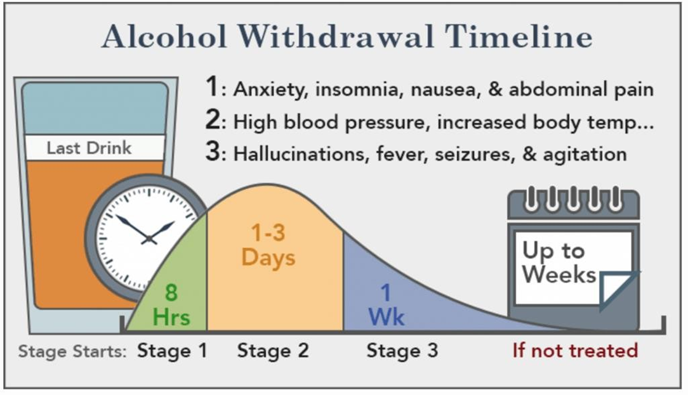A nurse is preparing a presentation about alcohol withdrawal. Which of the following findings should the nurse include in the presentation?
Decreased blood pressure
Respiratory depression
Muscle aches
Hallucinations
The Correct Answer is D
D. Hallucinations, particularly visual hallucinations, are a common manifestation of alcohol withdrawal, typically occurring within 12 to 24 hours after the last drink. These hallucinations can be vivid and may involve seeing objects, people, or animals that are not actually present.

A. Hypertension (high blood pressure) is more commonly associated with alcohol withdrawal, especially during the acute phase.
B. Respiratory depression, characterized by slowed or shallow breathing, is not a typical feature of alcohol withdrawal.
C. Muscle aches are not typically associated with alcohol withdrawal. Instead, symptoms such as tremors, agitation, and insomnia are more common during alcohol withdrawal.
Nursing Test Bank
Naxlex Comprehensive Predictor Exams
Related Questions
Correct Answer is C
Explanation
C. Tardive dyskinesia (TD) is a movement disorder characterized by involuntary, repetitive movements of the face, tongue, lips, and extremities, often as a side effect of long-term use of antipsychotic medications such as fluphenazine. Valbenazine is a medication approved for the treatment of tardive dyskinesia in adults
A. Diphenhydramine is an antihistamine medication with anticholinergic properties used in acute dystonia
B Naloxone is an opioid antagonist used to reverse opioid overdose by blocking the effects of opioids on opioid receptors. It is not indicated for the treatment of tardive dyskinesia.
D. Fluoxetine is a selective serotonin reuptake inhibitor (SSRI) antidepressant
Correct Answer is A
Explanation
A. Social cognition refers to the ability to understand and interpret social cues, including emotions, intentions, and interpersonal interactions. Asking the client to identify emotions on faces depicted on cards assesses their ability to recognize and interpret facial expressions, which is a fundamental aspect of social cognition.
B. Repeating a list of words primarily assesses verbal memory and recall, which may be impaired in dementia but does not specifically target social cognition.
C. Interpreting a sequence of pictures may assess aspects of visual processing, memory, and problem-solving abilities but does not specifically target social cognition.
D. Imitating gestures of learned movements may assess motor skills and imitation abilities but does not specifically target social cognition.
Whether you are a student looking to ace your exams or a practicing nurse seeking to enhance your expertise , our nursing education contents will empower you with the confidence and competence to make a difference in the lives of patients and become a respected leader in the healthcare field.
Visit Naxlex, invest in your future and unlock endless possibilities with our unparalleled nursing education contents today
Report Wrong Answer on the Current Question
Do you disagree with the answer? If yes, what is your expected answer? Explain.
Kindly be descriptive with the issue you are facing.
